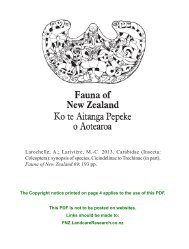PDF File - Landcare Research
PDF File - Landcare Research
PDF File - Landcare Research
You also want an ePaper? Increase the reach of your titles
YUMPU automatically turns print PDFs into web optimized ePapers that Google loves.
Hieracium crown hover fl y<br />
(Cheilosia psilophthalma)<br />
Hieracium gall midge (Macrolabis pilosellae)<br />
Hieracium gall wasp (Aulacidea subterminalis)<br />
Hieracium plume moth (Oxyptilus pilosellae)<br />
Hieracium root hover fl y (Cheilosia urbana)<br />
Crown feeder, limited releases made so far, establishment success unknown, rearing diffi culties need to<br />
be overcome to allow widespread releases to begin.<br />
Gall former, widely released and has established but is not yet common at sites in both islands, impact<br />
unknown but very damaging in laboratory trials.<br />
Gall former, widely released and has established but is not yet common in the South Island, impact<br />
unknown but reduces stolon length in laboratory trials.<br />
Foliage feeder, only released at one site so far and did not establish, further releases will be made if<br />
rearing diffi culties can be overcome.<br />
Root feeder, limited releases made so far, establishment success unknown, rearing diffi culties need to be<br />
overcome to allow widespread releases to begin.<br />
Hieracium rust<br />
Leaf rust fungus, self-introduced?, common, may damage mouse-ear hawkweed but plants vary in<br />
(Puccinia hieracii var. piloselloidarum)<br />
susceptibility.<br />
Heather beetle (Lochmaea suturalis) Foliage feeder, released widely in Tongariro National Park, some damaging outbreaks now starting to<br />
occur, also established near Rotorua and severely damaging heather there.<br />
Lantana plume moth<br />
(Lantanophaga pusillidactyla)<br />
Mexican devil weed gall fl y<br />
(Procecidochares utilis)<br />
Mist fl ower fungus (Entyloma ageratinae)<br />
Mist fl ower gall fl y (Procecidochares alani)<br />
Nodding thistle crown weevil<br />
(Trichosirocalus horridus)<br />
Nodding thistle gall fl y (Urophora solstitialis)<br />
Nodding thistle receptacle weevil<br />
(Rhinocyllus conicus)<br />
Old man’s beard leaf fungus<br />
(Phoma clematidina)<br />
Old man’s beard leaf miner (Phytomyza vitalbae)<br />
Old man’s beard sawfl y (Monophadnus spinolae)<br />
Flower feeder, self-introduced, distribution and impact unknown.<br />
Gall former, common, initially high impact but now reduced considerably by Australian parasitic wasp.<br />
Leaf smut, common and often causes severe damage.<br />
Gall former, now well established and common at many sites, in conjunction with the leaf smut provides<br />
excellent control of mist fl ower.<br />
Root and crown feeder, becoming common on several thistles, often provides excellent control in<br />
conjunction with other nodding thistle agents.<br />
Seed feeder, becoming common, can help to provide control in conjunction with other nodding thistle<br />
agents.<br />
Seed feeder, common on several thistles, can help to provide control of nodding thistle in conjunction with<br />
the other nodding thistle agents.<br />
Leaf fungus, initially caused noticeable damage but has since either become rare or died out.<br />
Leaf miner, common, only one severely damaging outbreak seen, appears to be limited by parasites.<br />
Foliage feeder, limited widespread releases have been made, has probably failed to establish.<br />
Phoma leaf blight (Phoma exigua var. exigua) Leaf spot fungus, self-introduced, becoming common, can cause minor–severe damage to a range of<br />
thistles.<br />
Scotch thistle gall fl y (Urophora stylata) Seed feeder, limited releases to date, establishing readily, impact unknown.<br />
Tradescantia leaf beetle (Neolema ogloblini)<br />
Tradescantia stem beetle (Neolema abbreviata)<br />
Tradescantia tip beetle (Lema basicostata)<br />
Cinnabar moth (Tyria jacobaeae)<br />
Ragwort crown-boring moth<br />
(Cochylis atricapitana)<br />
Ragwort fl ea beetle (Longitarsus jacobaeae)<br />
Ragwort plume moth (Platyptilia isodactyla)<br />
Ragwort seed fl y (Botanophila jacobaeae)<br />
Greater St John's wort beetle<br />
(Chrysolina quadrigemina)<br />
Lesser St John’s wort beetle (Chrysolina hyperici)<br />
St John’s wort gall midge (Zeuxidiplosis giardi)<br />
Foliage feeder, permission to release granted in 2008, releases fi nally got underway in autumn 2011 after<br />
beetle successfully cleared of a gut parasite, widespread releases now planned.<br />
Tip feeder, permission to release granted in 2011 and it is hoped releases can begin later this year.<br />
Stem borer, permission to release granted in 2011 and it is hoped releases can begin later this year.<br />
Foliage feeder, common in some areas, often causes obvious damage.<br />
Stem miner and crown borer, limited number of widespread releases made in 2006/07, establishment<br />
looking unlikely.<br />
Root and crown feeder, common in most areas, often provides excellent control in many areas.<br />
Stem, crown and root borer, widespread releases made in past 5 years, appears to be establishing readily<br />
and reducing ragwort already at some sites.<br />
Seed feeder, established in the central North Island, no signifi cant impact.<br />
Foliage feeder, common in some areas, not believed to be as signifi cant as the lesser St John’s wort<br />
beetle.<br />
Foliage feeder, common, often provides excellent control.<br />
Gall former, established in the northern South Island, often causes severe stunting.<br />
Woolly nightshade lace bug (Gargaphia decoris) Sap sucker, permission to release granted by ERMA in 2009, releases began in late 2010 and widespread<br />
releases are continuing.<br />
15
















